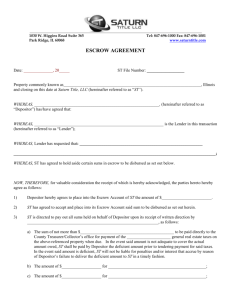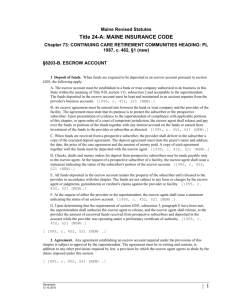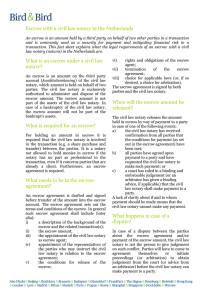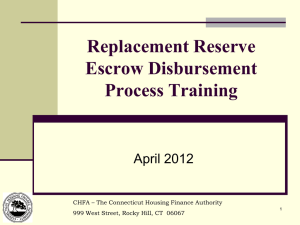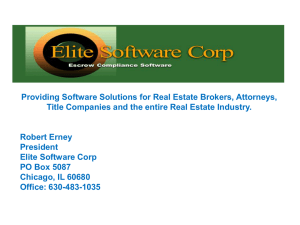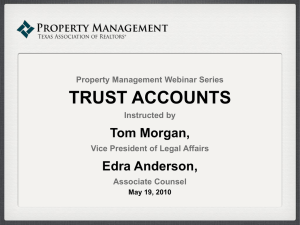What is an escrow? - Windy City Summit
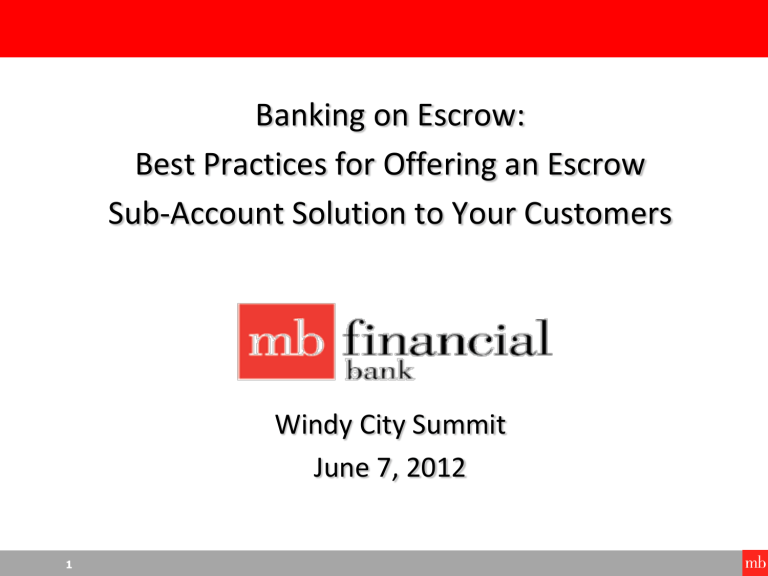
1
Banking on Escrow:
Best Practices for Offering an Escrow
Sub-Account Solution to Your Customers
Windy City Summit
June 7, 2012
2
Session Objectives
Obtain knowledge in what escrow sub-accounting is, who uses it, and how it works
Gain a better understanding of the current trends in escrow sub-accounting
Learn what financial institutions are doing to offer escrow accounting solutions
Review common best practices to implement escrow accounting solutions
3
Situation Analysis and Current Trends
Joseph Vitale
Vice President
Senior Product Manager
Situation Analysis – Escrows
What is an escrow?
An arrangement to help parties perform contracts and avoid disagreements
What parties are involved in an escrow arrangement?
A depositor, an escrow agent, a beneficiary
How does an escrow work?
The depositor is required to entrust money or property with an escrow agent
The escrow agent holds the deposit until it can be released to the beneficiary upon some future event
4
There are many uses for escrows of all which have contractual or legal obligations
5
Situation Analysis – Escrows
What types of funds are held in escrow?
Down payment for the purchase and sale of real property
Legal settlements, rent security deposits, new home construction, advance fees paid to brokers, membership fees, assisted care deposits
Who needs escrows?
Law Firms: client trusts, IOLTAs
Real Estate: property management, title companies, 1031 exchanges
Pre-Need: nursing homes, funeral homes, cemeteries, crematories
State Government: local bond funded projects
Federal Government: federal projects, EB-5
6
Situation Analysis – Escrow Rules and Regulations
Every industry that uses escrow accounts has unique and specific rules and regulations to follow based on several factors, including, but not limited to:
Interest payments
Taxes
Financial reporting
Oversight and disclosure
Agreements and contracts
Funds management and disbursement
State and federal mandates
Each escrow application has unique rules and regulations
Situation Analysis – Escrow Accounting Products
Escrow accounting products have been increasing in demand and usage over the last few years. Businesses require more visibility into and control over accounts and can no longer wait for month end statements or rely on bank custodial management. Industry solutions typically have the following characteristics:
Web-based online reporting and account administration
Unlimited sub-accounts
Interest allocation and apportionment
Deposit and funds segregation
Reconcilement and adjustment identification
Statement and activity reporting
Document storage and retrieval
1099 reporting
Financial institutions have seen an increase in demand and adoption for escrow products
7
Situation Analysis – Escrow Accounting Products
Financial institutions are now developing escrow accounting products and services to meet the increasing demands of businesses. These products have a typical workflow in terms of how they are setup and used.
6.
7.
1.
2.
3.
4.
5.
Customer is setup on an escrow accounting product with master or main escrow account(s)
Customer creates subaccounts in the product off of the main interest bearing or noninterest-bearing account structures
As deposits come into the main account(s), they are posted to the product on a prior day or same day basis
If the subaccount is identified on the incoming deposit, the subaccount is automatically updated with the deposit, or if not identified, unallocated funds will need to be reconciled
As the bank calculates and posts interest to the main account, all subaccounts that accrue interest are automatically updated
Customer can generate reports to verify transaction activity and reconcilement
When it comes time to disburse the funds, customer can initiate payments or write a check to the account holder and then close the sub-account
8
Escrow accounting products bring reporting and administration tasks online
Situation Analysis – Escrow Accounting Products
Typical escrow account structure hierarchy:
Escrow Account
Master Account 1
(Interest Bearing)
Master Account 2
(Non-interest Bearing)
Sub-account 1
Account Holder
Sub-account 2
Account Holder
Sub-account 1
Account Holder
9
This structure allows organizations to build unlimited subaccount hierarchies
Industry Trends – Risk and Compliance
Financial institutions and businesses are experiencing a shift in oversight, risk management, regulatory changes, and enhanced compliance standards.
Regulatory
Compliance
RISK CATEGORY
Risk Management
Business Resumption and Continuity
RISK
Asset allocation
Counterparty
Currency
Economic
Direct, industry specific
Indirect, banking
Direct, industry specific (SOX, SSAE 16)
Indirect, banking
Natural disasters are no longer a once or twice in a lifetime occurrence
Pandemic, operational or process breakdown
The business community is dealing with an onslaught of risk and regulatory challenges
10
Industry Trends – Technology
Technology is changing rapidly and organizations are dealing with when to begin to upgrade, change, and use new systems to run the business.
Budgeting
New products and services
Risk and compliance
Core Systems
Accounting, Billing/Purchasing
Treasury Management Workstations, ERP
DDA, Analysis, Payment systems
Platforms
Online banking
Software as a Service (SaaS)/Cloud mCommerce (mobile)
Go Green/Eco-friendly initiatives
11
Businesses have been on the same system platform for an average of 7-10 years
Industry Trends – Fraud and Security
Fraud prevention and overall transaction security is a primary concern for all organizations.
Online Banking
Secure payments and account/transaction data
Protected browser sessions
Timely alert notifications
Fraud Mitigation
Check and ACH Positive Pay, blocks, filters
Dual control, out of band, security tools
User access permissions, transaction limits
Risk Management
Enterprise risk
Predictive analysis and scoring
Back office system detection
12
The expectation is we all must do more to assist in fraud education and prevention
13
Best Practices in Partnering with a Bank
Judy Hill
Senior Vice President
Sales Advisory
Determining the Need for an Escrow Partner
Do you have a need to segregate accounts and keep funds separate for tracking and reporting?
Would you like the convenience of opening and closing escrow accounts quickly online?
Would you like the ability to attach relevant account documents such as W9s, legal agreements, and service contracts directly to online accounts?
Do you require visibility and transparency into all main and subaccounts to meet audit and compliance policies?
Is FDIC insurance important to your customers?
Would you like to offer your clients interest on the earnest money or escrow funds you manage and administer for them?
Are you required to create and distribute 1099s?
14
Case Study: Real Estate Brokerage Company
Company Overview
40 offices across the county
In excess of 1,500 active brokers
Current Environment
150 escrow deposits per month
Average deposit amount $13,000
Average deposit time 90 days
75% non-interest bearing deposits
25% interest bearing deposits
150 distributions per month
Escrow deposits tracked manually via spreadsheet
Interest calculated manually at time of disbursement
Manual bank reconciliation
Mission Impossible – accurate production of 1099s
15
Challenge with Manual Process
16
Challenges with Manual Process
Challenge
It takes too long and it’s too expensive to open separate accounts at the bank.
I need to keep funds segregated for tracking and management.
I am required to pay interest on some of the accounts and can’t easily calculate it.
Issuing 1099’s at year end is a significant task.
Solution
You can administer the sub accounts online without contacting the bank. Your bank should allow for an umbrella agreement that covers all of the OFAC and KYC procedures.
These solutions maintain a logical hierarchy for Master and Sub
Accounts - allowing you to maintain and view each account separately or you can group accounts uniquely to provide information the way you need it.
Interest can be allocated at both the Master and Sub Account level and can be applied using different rates for each account.
1099 reporting is facilitated to work within your current reporting process and will provide more efficiency. Helping you to meet IRS reporting requirements.
Accounts can be set-up so that all funds have full FDIC coverage.
My customers demand FDIC coverage on their deposits.
I have separate systems to access important client documents of escrow accountholders.
These solutions have a document upload function so you can attach all relevant documents like escrow agreements and invoices directly to online profiles.
17
Value Proposition for Businesses
Feature
Online system access
Escrow sub-accounting
Interest accrual
Risk and compliance
Reporting
Benefit
Users manage all accounts and administration online in a separate product module in a safe and secure environment
Main accounts can be broken down into subaccounts for individual tracking and reporting and store related documents like W9s and agreements
Interest can be allocated at both the main and sub-account level and can be different for each account
Complete audit trails, visibility and transparency into all account activity to meet risk and compliance standards
Statement reports, charts, graphs, analytics, and 1099 reporting
18
There are several benefits businesses can take advantage of from day one
Best Practices in Implementing Escrow Solutions
Analyze your current process and escrow needs
What are your challenges
Where are your risks
Outline all legal and compliance requirements
Work with your financial institution to:
Understand the options for the account structure to best meet your needs
Identify operational efficiencies based on the features of your banking partner’s product offering
Understand the value proposition for your customers
Create business case to sell internally
Use the IPDE method – Identify, Predict, Decide, and Execute
19
Summary
There is an increase in demand in the industry for online escrow subaccount solutions
State, federal, and industry regulations and compliance standards are driving adoption of escrow subaccount products
The primary market segments with escrow accounting needs are law firms, real estate, pre-need, and government
Escrow accounting solutions offer several key benefits to both businesses and financial institutions
Follow best practices when marketing and implementing escrow accounting products and services
Understanding your escrow needs and requirements is key to an effective program built to meet revenue goals, reduce costs, and satisfy compliance standards
20
